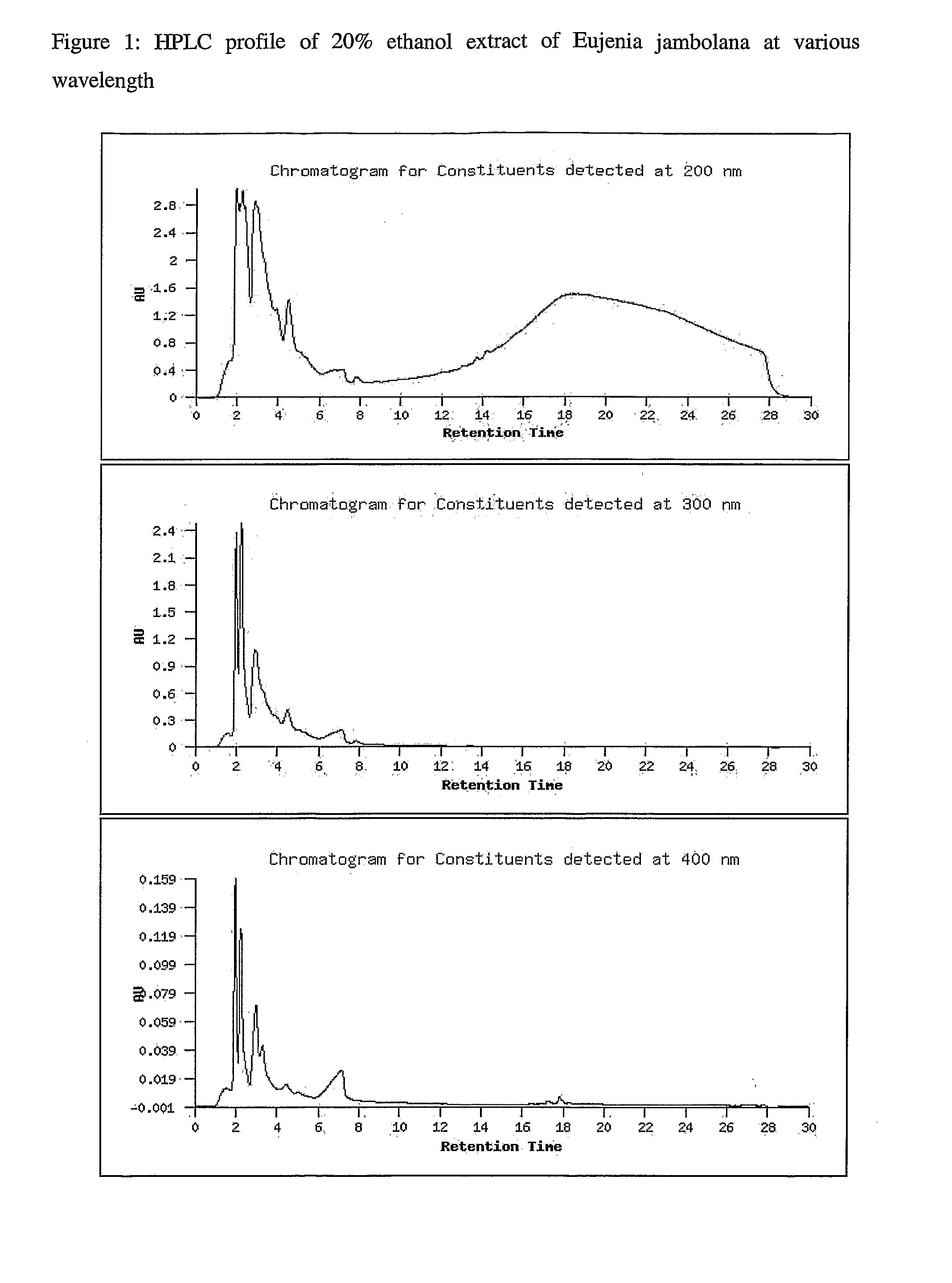Novel therapeutic extracts and molecules for degenerative conditions
a technology of plant extracts and molecules, applied in the direction of plant/algae/fungi/lichens ingredients, magnoliophyta medical ingredients, biocide, etc., can solve the problems of degenerative diseases, debilitating degenerative diseases, and affecting the life of affected people, and achieve the effect of preventing the uptake reducing the toxicity of sucrose added products
- Summary
- Abstract
- Description
- Claims
- Application Information
AI Technical Summary
Benefits of technology
Problems solved by technology
Method used
Image
Examples
example 1
Study of Insulin Mimetic Activity
[0061]“[3H]-deoxyglucose uptake by 3T3-L1 adipocytes” is the classic assay that measures the ability of bioactive lead candidates to improve insulin sensitivity in stimulation of glucose uptake by adipocytes. The assay can also be adapted to measure insulin-mimetic activity by measuring stimulation of glucose uptake by plant extracts in the absence of insulin.
[0062] In this study we are looking for molecules that have insulin mimetic activity. So we measured the uptake of 3H-de-oxyglucose in adipocytes by incubating them with plant extracts in the absence of insulin. Mature adipocytes derived from 3T3-L1 fibroblasts were incubated with plant extracts alone followed by [3H]-deoxyglucose uptake assay as described in details under the methods.
Method:
3T3-L1-Cell Culture
[0063] 3T3-L1 fibroblasts were cultured in DME-F12 media containing 10% FCS, NEAA, glutamine, antibiotics, anti-mycotics, etc., in an atmosphere of 5% CO2 at 37° C. Fibroblasts were...
example 2
Study of Cell Viability and Respiratory Physiology
[0069] Crude plant extracts solubilized in a “compatible” solvent such as dimethylsulfoxide (DMSO) often affect the viability of cells in culture when incubated for long periods. It is necessary to optimize the appropriate dilution and time of incubation of cells with plant extracts under which cell viability remains unaffected. The reduction of tetrazolium salts is now widely accepted as a reliable way to examine cell proliferation. The yellow tetrazolium salt, (MTT) 3-(4,5-dimethylthiazolyl-2)-2,5-diphenyltetrazolium bromide is reduced by metabolically active cells, in part by the action of dehydrogenase enzymes to generate reducing equivalents such as NADH and NADPH. The resulting intracellular purple formazan can be solubilized and quantified by spectrophotometric means.
MTT Assay to Determine Cell Viability when Incubated with Plant Extracts
Method:
3T3-L1-Cell Culture
[0070] 3T3-L1 fibroblasts were cultured in DME-F12 media...
example 2a
Study of Standardization of the Dilution of the Plant Extracts
[0072] 3T3-L1 fibroblasts were incubated with different concentrations of stock concentration of plant extracts (neat—50 μg dry extract dissolved in 300 μl DMSO, and 1:2 and 1:4 dilutions of it) for 24 hrs. The viability of the cells was assessed by MTT cell assays. Table 6 shows that neat extracts gave maximal MTT colorimetric reading. The standardization study was done with selective extracts only.
[0073] Table 6 and 7 show the standardization of the optimal concentration of plant extract that retains cell viability by MT assay. 3T3-L1 fibroblasts were incubated with different concentrations of stock concentration of plant extracts (neat—50 μg dry extract dissolved in 300 μl DMSO, and 1:2 and 1:4 dilutions of it) for 24 hrs. The viability of the cells was assessed by MTT cell assays. Table 6 shows that neat extracts gave maximal MTT colorimetric reading. The standardization study was done with selective extracts only. ...
PUM
 Login to View More
Login to View More Abstract
Description
Claims
Application Information
 Login to View More
Login to View More - R&D
- Intellectual Property
- Life Sciences
- Materials
- Tech Scout
- Unparalleled Data Quality
- Higher Quality Content
- 60% Fewer Hallucinations
Browse by: Latest US Patents, China's latest patents, Technical Efficacy Thesaurus, Application Domain, Technology Topic, Popular Technical Reports.
© 2025 PatSnap. All rights reserved.Legal|Privacy policy|Modern Slavery Act Transparency Statement|Sitemap|About US| Contact US: help@patsnap.com



